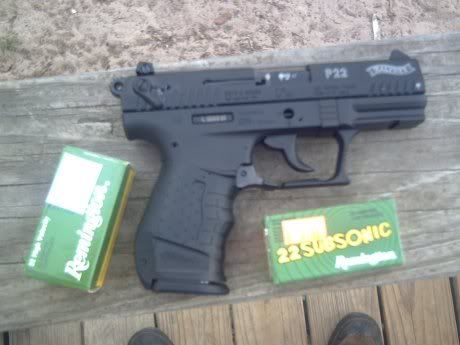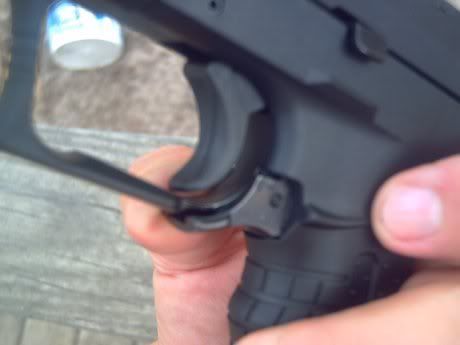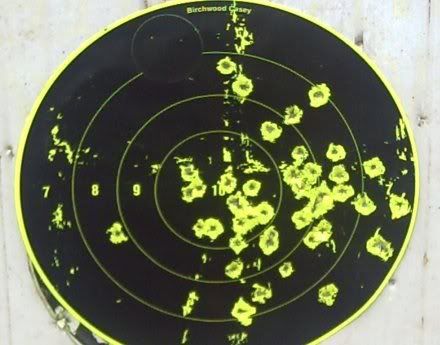The P22 is designed to be nearly identical to, although smaller than, Walther's P99 (a 9mm or .40 S&W gun). I decided to take my new one out today for some shooting. Please excuse some of the blurry pictures, I was in a hurry because it was about to start raining (unfortunately, the rain didn't last long).

Ammo being tried out today was Remington standard "High Velocity" .22 LR and Remington Subsonic .22 LR as pictured. Grouping and accuracy didn't seem to matter--both kinds of ammo shot the same. Recoil was more noticeable with the High Velocity ammo, but it's a .22, so who cares? Just above the trigger in the above picture is the trigger lock, if you ever care to use it.
As usual, I have to make some left-handed comments. Shooting in the isosceles position kept popping the Subsonic empties right back into my face, and one even went down my shirt (ouch). Adjusting to sort of a hybrid isosceles/Weaver stance took care of that (I just shifted my feet a little). The High Velocity empties ejected with more force, and flew clear of me without me even noticing them.
As usual, I have to make some left-handed comments. Shooting in the isosceles position kept popping the Subsonic empties right back into my face, and one even went down my shirt (ouch). Adjusting to sort of a hybrid isosceles/Weaver stance took care of that (I just shifted my feet a little). The High Velocity empties ejected with more force, and flew clear of me without me even noticing them.

I'm trying in this picture to illustrate the ambidextrous magazine release located on the trigger guard. The mag release makes this gun very lefty-friendly. The safety is also ambidextrous.
The P22 has what they call a "loaded chamber indicator," but it's the kind that is simply a small gap through which to look and see if it's loaded. It's not the tactile kind. Personally I'd rather just press-check it.
It has a magazine disconnect so the hammer won't fall with the magazine removed. What may seem odd to some (it did to me), is that when the safety is on and the magazine installed you can pull the trigger and the hammer will fall. However, there is a hammer block that prevents it from transferring the impact to the cartridge. According to Walther, this is the decocker. Still, it seems odd to use the trigger for a decocker rather than have a separate decocking lever.
To disassemble, first ensure it is not loaded, then lock the slide back and remove the magazine. Slide the take-down lever down. This is not actually a lever, it is more of a sleeve. It must be pulled down with equal force on either side. If you try to walk it down one side at a time, it won't work.
The P22 has what they call a "loaded chamber indicator," but it's the kind that is simply a small gap through which to look and see if it's loaded. It's not the tactile kind. Personally I'd rather just press-check it.
It has a magazine disconnect so the hammer won't fall with the magazine removed. What may seem odd to some (it did to me), is that when the safety is on and the magazine installed you can pull the trigger and the hammer will fall. However, there is a hammer block that prevents it from transferring the impact to the cartridge. According to Walther, this is the decocker. Still, it seems odd to use the trigger for a decocker rather than have a separate decocking lever.
To disassemble, first ensure it is not loaded, then lock the slide back and remove the magazine. Slide the take-down lever down. This is not actually a lever, it is more of a sleeve. It must be pulled down with equal force on either side. If you try to walk it down one side at a time, it won't work.

Lift the back end of the slide up slightly and carefully allow it to go forward. As with some other semi-autos, if you aren't careful the spring could pop out.

The P22 has a fixed barrel. It comes with an accessory wrench to remove the barrel. Walther also produces an optional 5" barrel which can be installed by the owner--no gunsmithing required. The 5" barrel is called the "target barrel." I don't have one, yet. The gun also comes with three front sights of varying heights. The factory installed front sight can be removed with a screwdriver and a new one installed by the owner. The rear sight is micrometer adjustable for windage. There is also a second palm swell that can be owner-installed on the back of the grips to increase the size of the grips if desired. I plan on trying that out too, but I haven't yet. It also comes with two 10-round magazines, and it has a light rail.
The tricky part is putting the gun back together when you're finished cleaning it. In the little accessory bag which includes the wrench is a plastic rod. This rod is used to guide the guide rod back into its respective hole in the end of the slide.


Carefully--making sure everything stays lined up straight--pull the slide back into its locked open position. The plastic guide rod will pop out unless you have a third hand to catch it, so be sure it pops out where it won't get lost. On mine, there is one extra step which took me a while to figure out. After the slide is back in its locked open position, a light tap to the back of the slide with the heel of the hand is required to finally seat it into its correct position so that it can slide forward again. After sliding it forward, push the takedown lever back into its previous position, and lower the hammer. You're done.
How does it shoot? you ask. This gun shoots way better than I do, but that can be remedied with practice, which is the main reason I bought this gun.

This 8" Shoot-N-See target shows--although it's hard to count them all--40 bullet holes from a distance of 25 feet. I am almost certain the rightward drift of the group is due to me rather than the gun. I should mention that for the last two magazines, I was shooting about as fast as I could and still keep them all in the black. (The extra black circle that was stuck on there didn't cover any holes, that was just my son sticking a sticker there because he likes to do that sort of thing). Other bullet holes in the backing are from previous sessions.
This gun is sweet. It is so comfortable that I could easily just stand and shoot all day. I just need to teach the kids how to load the magazines so they can load while I shoot.
If Walther were to ask me for any suggestions, I would recommend an extended magazine. By the way, here's a factory picture of the gun with the 5" barrel and the accompanying barrel stabilizer installed.

Visit Walther's P22 page for technical details.
MSRP on this little guy is $295. I got mine brand new for $243 plus tax. An affordable gun that shoots affordable ammo.
UPDATE: Check the comments for another tip on how to reassemble the gun without using the plastic guide rod. I'll have to try that!
COMMENTS ARCHIVED FROM THE ORIGINAL POST BELOW:
by drstrangegun:
Instead of the little plastic rod, when I reassemble my P22 what I do is bunch the recoil spring up on the guide rod, insert the rod through the slide and hold the rod on the outside (keeping the spring compressed), I then put the slide back on the gun partially and release the rod, and wiggle it a little until the rod pops into the retaining hole in the frame. It's much faster and requires no extra parts to lose.by Chris Byrne:
I do the exact same trick for reassembling mine.by anonymous:
Ok some important notes on the P22.
1. The safety will loosen up and come on by itself over time. DO NOT OVERTIGHTEN the screws that hold the safety levers onto the safety barrel. This will split them, AND reduce the tension on the barrel making the problem worse. Find the right tension and loctite the screws there, but check them every one in a while.
2. Cleaning... Get yourself some plastic safe but otherwise very strong solvent, a solvent safe container to submerge the gun completely, and a can of compressed airto blow the solvent out again.
Trust me, it's the only way to clean the crud out of the little spaces that you can't get to. You literally cannot diassemble this gun far enough to clean it completely.
Once youlve dunked and blown, reoil the gun VERY LIGHTLY, because too much oil jsut invites more crud.
3. DO NOT OVERTIGHTEN THE BARREL NUT. The barrel shroud will actually peen down the key in the aluminum barrel lug mounted in the frame. This is not a replaceable part.
Dont let these points scare you off, or suggest I don't love the gun; I do. It's a great little pistol, and everyone should own one. You jsut need to know those particular idiosyncracies.
The NEWER P22's are labeled with an "L" prefix before the serial number. These seem to have less problems with misfires as the older (pre-2004) models did. Also, be sure to check the magazine for the letter "A". These are the newer mags that Walther replaced the old, "defective" ones with. Other than that this is the best little .22LR auto I've owned. 40-gr. CCI mini-mags are by far the best rounds for this gun. Enjoy.by anonymous:
Due to the inertial firing pin, the P22 should not be "dry fired" extensively during aiming practice. Doing so not only risks deformation of the chamber face, but the repeated forward action of the firing pin into and beyond the space normally occupied by the rimfire casing will eventually distort the firing pin spring. If this happens, the firing pin will no longer return vigorously to its default at-rest position at the extreme of its possible rearward travel within the breach block. This could result in less or none of the firing pin's rear surface portruding beyond the rear of the breach block for impact by the hammer.Other comments at the original post.
I have the extender and Paid $299 for the whole deal. I like it.
ReplyDeleteI've fired it from a rest and can get decent groups but the magazine release is still a pain to get used to.
I bought it mostly for the looks.
So that's what that little rod thingy is for ... thanks for this!
ReplyDeleteThere is a newer version of the magazine than the "A" model and it is stamped with a "B" after the SN
ReplyDeleteI personally like Walther guns but the way you describe its features will must catch the action who don't have any interest in guns.
ReplyDelete